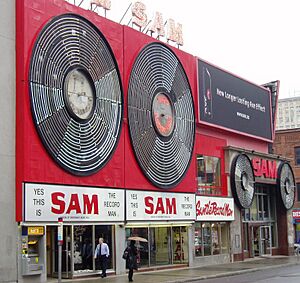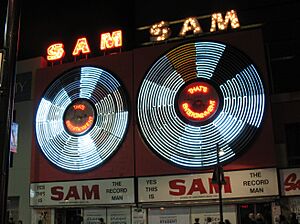Sam the Record Man facts for kids
 |
|
| Private | |
| Industry | Record store |
| Fate | Closed |
| Founded | 1937 |
| Defunct | 2007 (one remaining former franchise store in Belleville, Ontario) |
| Headquarters | Toronto, Ontario, Canada |
|
Key people
|
Sidney Sniderman Sam Sniderman Jason Sniderman Robert "Bobby" Sniderman Lana Sniderman |
| Products | Music |
Sam the Record Man was a famous Canadian music store chain. For a long time, it was the biggest music seller in Canada. In 1982, its ads proudly said it had "140 locations, coast to coast."
The most famous Sam the Record Man store was in Toronto, at 347 Yonge Street. It opened there in 1961 and stayed until 2007. This store was a big part of Toronto's music scene in the 1960s. It was near other music stores and clubs.
The Yonge Street store became a popular place. People loved to explore its huge selection of LP records, and later, cassettes and compact discs. It grew from one small shop to take up a whole city block. Sam's even competed with another big music store, A&A Records, which was just down the street. The original building was taken down between 2009 and 2011. Now, Toronto Metropolitan University's Student Learning Centre stands there. The store's famous neon sign has been fixed up and moved to a new spot near Yonge-Dundas Square.
The rise of the Information Age and new competitors like HMV Canada made things tough for Sam the Record Man. The company went bankrupt in 2001. But its main store stayed open until 2007. Today, only one independent store in Belleville, Ontario, still uses the Sam the Record Man name.
Contents
How Sam the Record Man Started
The story of Sam the Record Man began in 1937. It was started by Sam Sniderman and Sidney Sniderman. They opened a record department inside their family's radio store, Sniderman Radio Sales & Service, in Toronto.
In 1959, their music shop, called Sniderman's Music Hall, moved to Yonge Street. This was so they could compete with A&A Records. On Labour Day in 1961, the store moved again to 347 Yonge Street. This spot became a well-known landmark in Toronto. The main A&A Records store was also very close by.
Iconic Neon Signs of Sam's
The Yonge Street store was famous for its cool and unique signs. As Sam the Record Man grew, it added its first spinning record sign. This sign was huge, about 7.5 meters (24.6 feet) wide and 8 meters (26.2 feet) tall. It was added around 1969–70.
A second spinning record sign was added in 1987. This one was just north of the first. In the same year, the big letters spelling "SAM" were put above the records. It took 550 light bulbs to light up these "SAM" signs! Also, the words "Yes this is SAM the Record Man" were added below. The words "That's Entertainment" were put in the middle of the spinning records.
The buildings where the signs hung were old structures. They were later taken down to make way for new buildings.
How the Store Grew Over Time
In the 1960s, the main store at 347 Yonge Street got bigger. A third floor was added to the back. This area was used as a bargain basement and later for selling videos and concert tickets.
Sam also bought another property nearby. This became "Sam the Tape Man," selling different types of music tapes. There was even a Chinese restaurant upstairs! Later, the tape department moved back into the main store.
In the 1970s, Sam bought the parking lot behind a nearby bank. An annex building was built there. This new space held the classical music department and later the tape department.
In the 1980s, Sam bought the building next door at 349 Yonge Street. This building was connected to the main store. The new space allowed for a much larger CD department. A third floor was added to this building for video rentals and staff areas.
By the mid-1990s, Sam the Record Man started selling computer software and games. This new department was called "Sam The Interactive Man." It was located on the newly connected third floors.
In 1991, Sam bought the bank property next door. This allowed the store to expand even more. The Pop/Rock music department moved to the ground floor of this new area. Large outdoor video screens were put on the roof of the former bank building. More neon signs were added, including a copy of the very first sign from Sniderman Radio Sales & Service.
In the 2000s, after the company went through some tough times, the store was renovated again. Different music sections were moved around. A new DVD department was created in the former classical annex. It had a chandelier, spotlights, and even a small stage for live performances! A café was also added to the Pop/Rock department.
Famous Visitors to Sam's
Sam Sniderman was known for helping new artists in the Canadian music industry. He helped start the careers of famous musicians like Anne Murray, Rush, Gordon Lightfoot, and The Guess Who. These artists often visited the store.
The store was also known for its huge sales, especially on Boxing Day. Shoppers would line up for blocks in the cold to get discounted records, CDs, and videos. Many walls inside the store had autographs and photos of famous musicians and celebrities who had visited. There were also in-store performances by artists like Radiohead and Meat Loaf.
Sam the Record Man stores were big supporters of Canadian artists. They featured their music with special displays and concerts. Sam Sniderman also helped create rules that made Canadian radio stations play more Canadian music. This helped many Canadian musicians become famous in their own country.
The Chain's Growth and Decline
In the late 1960s, Sam Sniderman expanded the business. He opened more stores, both franchises and company-owned. The expanded business was called Roblan Distributors. A large warehouse was set up to supply all the stores.
The chain grew to 130 stores across Canada. For a while, it was the top music retailer in the country. The chain even published a free music magazine called Network.
Bankruptcy and Final Closure
In 2001, the Sam the Record Man chain faced tough competition. People were also downloading music for free from the internet. These challenges forced the company to declare bankruptcy. Most of its 30 company-owned stores closed. The Sniderman family had been paying off the company's debt for five years, but they could no longer afford to lose money.
Sam Sniderman's sons, Jason and Robert, took over the main Yonge Street store. They kept it running until May 29, 2007. They announced the store would close permanently on June 30, 2007. They said that new technology had changed how people bought music, making it hard for the store to survive.
The closing of the flagship store left only two franchise stores in Ontario. The Sarnia store closed in 2009. The very last Sam the Record Man store, an independent franchise in Belleville, Ontario, remained open until 2024.
Sam's Store in Movies and TV
The double-disc neon sign of Sam the Record Man often appeared in movies filmed in Toronto. For example, it can be seen in the 2008 movie The Incredible Hulk during the final battle. It also appeared in the TV series Flashpoint, which is set in Toronto.
Saving the Iconic Sign
When the store was closing, supporters started a Facebook group to save the neon spinning record signs. This group gained over 18,000 members. On June 14, 2007, it was announced that the signs would be auctioned off.
However, on June 22, 2007, the Toronto city council voted to protect the entire property as a heritage site. This protected the building and its famous signs.
The property at 347 Yonge Street was very valuable. Toronto Metropolitan University (then Ryerson University) bought it in early 2008 for new campus buildings. On October 4, 2008, the iconic neon signs were lit for the last time as part of Toronto's Nuit Blanche festival. The signs were then taken down, and the building was demolished by early 2010. The new Student Learning Centre opened on the site in February 2015.
Under a heritage agreement, the university was supposed to restore the spinning record signs and put them on the new building. But the university later said the signs didn't fit their plans. In July 2014, the city council approved a new plan. The university would pay to install and maintain the sign on top of a city-owned building at 277 Victoria Street. This new location is two blocks away from the original spot.
In July 2017, the university announced that the restoration of the nearly 50-year-old neon signs had begun. The signs were re-installed and lit up again in 2018, overlooking Yonge-Dundas Square.
Images for kids







